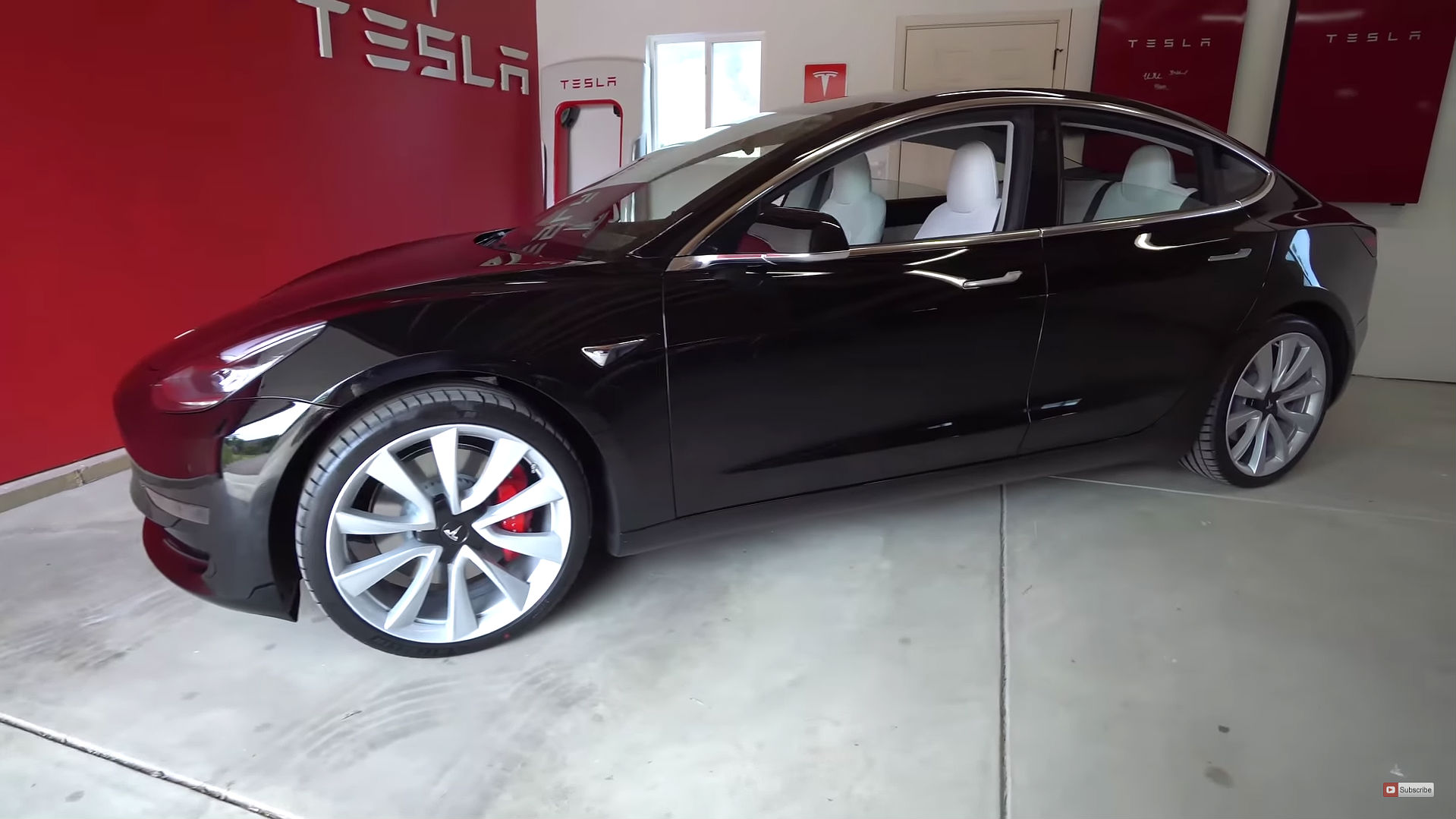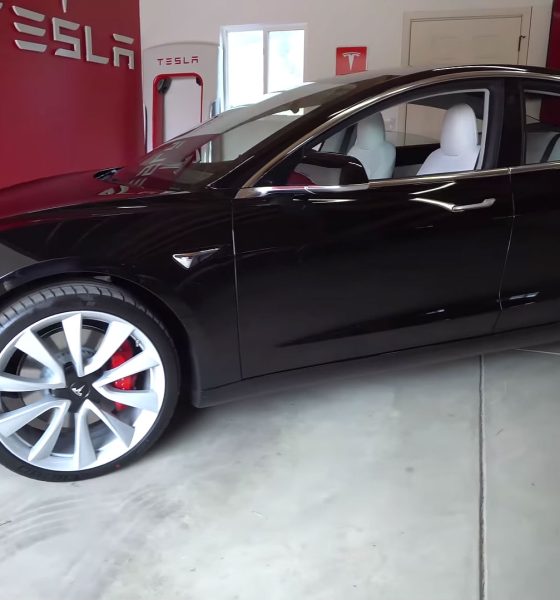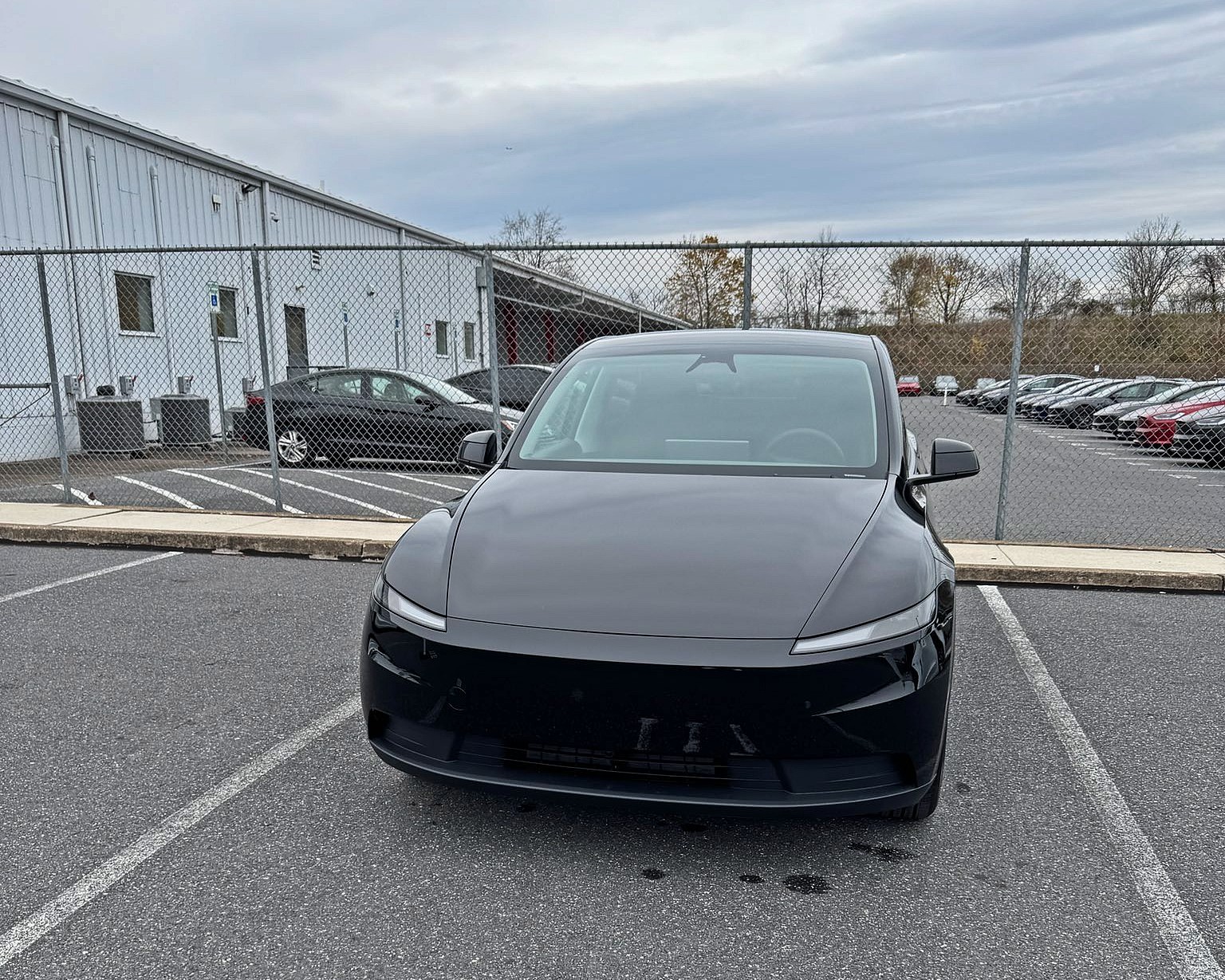

News
Tesla Model 3 Performance 0-60 mph put to the test in latest acceleration run
Tesla Model 3 Dual Motor Performance is marketed as an electric car that is quick, nimble, and capable of dominating track legends such as the BMW M3 and Porsche Boxster. With a 0-60 mph time of 3.5 seconds and a top speed of 155 mph, the Model 3 Performance packs some serious speed, thanks to its dual electric motors that feature a combined 450 hp and 471 lb-ft of torque.
Tesla owner-enthusiast DÆrik of YouTube, who is known for installing a life-size working Supercharger for his Model S in his garage, was able to borrow one of the first Model 3 Performance units in Colorado. The YouTube host noted that the carbon fiber rear spoiler of the vehicle, as well as its underlined Dual Motor badge, have not been fitted on the electric car yet.
DaÆrik’s 0-60 mph tests of the Model 3 Performance were conducted from a dead stop with the vehicle’s battery having 220 miles of range left. The first launch was immediately impressive, with the electric car hitting 60 mph in 3.22 seconds. The second launch was even better, with the Model 3 Performance doing the 0-60 mph sprint in 3.15 seconds. This time around, the Model S owner opted to push the car further, hitting 90 mph in 6.28 seconds. DÆrik noted that he was able to get the numbers of the two 0-60 mph runs by starting the video clip at 0 mph, ending it at 60 mph, and measuring the section frame-by-frame in Adobe Premiere Pro CC.
The Model 3 Performance has been earning much praise from professional auto reviewers such as Dan Neil of the Wall Street Journal, who lauded the car as a “magnificent” piece of automotive engineering that is “representative of the next step in the history of autos.” Other reviewers from Motor Trend and CNET Roadshow also praised the vehicle for its quickness and performance. While test drives of the Model 3 Performance reveal that the vehicle already has impressive acceleration, Tesla CEO Elon Musk has stated that the electric car could get even faster with a wider set of rear wheels and tires.
In an announcement on Twitter, Musk noted that the Michelin Pilot Sport 4S summer tires the Model 3 Performance come equipped with are maximized for a balance of range and performance. For those who do not mind sacrificing a little range in exchange for raw power, Musk advised that stickier and wider tires at the rear might lower the car’s 0-60 mph time to 3.3 seconds.
The Model 3 Performance starts at $64,000 before any options. Buyers of the electric car can add on Tesla’s Performance Package, a $5,000 upgrade that includes 20″ Performance Wheels, Michelin Pilot Sport 4S summer tires, a carbon fiber rear spoiler, aluminum alloy pedals, and a top speed boost that enables the electric car to max out at 155 mph. With all options including White Seats, premium paint, Enhanced Autopilot, and Full Self-Driving, the cost of the Model 3 Performance rounds out at $80,000, which is far more than the $35,000 price of the Standard Range RWD Model 3 but more affordable than comparable ICE-powered high-performance cars in its class, such as the BMW M3, Audi RS5, and the Mercedes AMG C 63 S Coupe, which can cost north of $100,000 with all options.
Watch DaÆrik’s 0-60 mph tests of the Model 3 Performance in the video below.

News
Tesla Full Self-Driving warrants huge switch-up on essential company strategy

Tesla Full Self-Driving has warranted a huge switch-up on an essential company strategy as the automaker is hoping to increase the take rate of the ADAS suite.
Unlike other automotive companies, Tesla has long been an outlier, as it has famously ditched a traditional advertising strategy in favor of organic buzz, natural word-of-mouth through its production innovation, and utilizing CEO Elon Musk’s huge social media presence to push its products.
Tesla has taken the money that it would normally spend on advertising and utilized it for R&D purposes. For a long time, it yielded great results, and ironically, Tesla saw benefits from other EV makers running ads.
Tesla counters jab at lack of advertising with perfect response
However, in recent years, Tesla has decided to adjust this strategy, showing a need to expand beyond its core enthusiast base, which is large, but does not span over millions and millions as it would need to fend off global EV competitors, which have become more well-rounded and a better threat to the company.
In 2024 and 2025, Tesla started utilizing ads to spread knowledge about its products. This is continuing, as Full Self-Driving ads are now being spotted on social media platforms, most notably, X, which is owned by Musk:
NEWS: Tesla is running paid advertisements on X about FSD (Supervised). Here’s an ad they started running yesterday: pic.twitter.com/IHVywLMyTd
— Sawyer Merritt (@SawyerMerritt) November 25, 2025
Interestingly, Tesla’s strategy on FSD advertising is present in Musk’s new compensation package, as the eleventh tranche describes a goal of achieving 10 million active paid FSD subscriptions.
Full Self-Driving is truly Tesla’s primary focus moving forward, although it could be argued that it also has a special type of dedication toward its Optimus robot project. However, FSD will ultimately become the basis for the Robotaxi, which will enable autonomous ride-sharing across the globe as it is permitted in more locations.
Tesla has been adjusting its advertising strategy over the past couple of years, and it seems it is focused on more ways to spread awareness about its products. It will be interesting to see if the company will expand its spending even further, as it has yet to put on a commercial during live television.
We wouldn’t put it out of the question, at least not yet.
News
Tesla Model Y Standard: first impressions from a Premium owner

Tesla was nice enough to hook us up with the new Model Y “Standard” trim for a few days, and while we’ll be sure to fill you in on the full experience in the coming days, there are a lot of differences we noticed right off the bat, which make the ownership experience different from the “Premium” configuration level.
I purchased a Model Y Long Range All-Wheel-Drive back in August and took delivery just two weeks later. Through the first three months of owning my car, I’ve come to love so many things about the Tesla experience.
I traded my ICE vehicle for a Tesla Model Y: here’s how it went
However, I was interested in experiencing the affordable trim and seeing whether I would miss any of the voided features of the “Premium” Model Y.
Through the first 24 hours, here are my first impressions of the Model Y Standard as a Premium trim level owner:
Overall Aesthetic
The lack of a light bar is not something that is a dealbreaker. In fact, I would argue that the Model Y Standard’s more traditional headlight design is just as pleasing from an aesthetic standpoint.
The car is great looking from top to bottom; there are not a substantial number of differences besides the lack of a lightbar on both the front and the back of the car.
Overall, it is a very sleek vehicle, but the major changes are obviously with the interior.
Interior Changes
This is where the big differences are, and some of the things I’ve gotten used to in the Premium are not included. If I didn’t have a Premium Model Y already, I’m not sure I’d miss some of the things that are not present in the Standard trim, but I believe I’d get annoyed with it.
First impressions:
✅ Interior is excellent. I definitely miss the additional storage already that is available in my Premium. I could definitely get over it though
✅ Noticeable step down in sound system. Long Time by Boston absolutely cranks in the Premium; it’s still very… https://t.co/JNWvxTd8p1
— TESLARATI (@Teslarati) November 25, 2025
Storage
The Premium has a large storage compartment between the cupholders and the wireless charger, which is not present in the Standard trim. Instead, it is more like the Cybertruck, as there is a pass-through and floor storage.
I think that the pass-through is nice, but the additional storage is something I take advantage of, especially as someone who films Full Self-Driving videos, which requires hauling mounts, GoPros, and other accessories.
The sleekness of the Premium trim is also something I prefer; I really enjoy having the ability to close those compartments and cover the cupholders.
Obviously, this is a really trivial issue and not something that is substantially impactful from an ownership experience. If I weren’t already an owner, I am not sure I’d even have something to complain about.
Material Differences
The Premium trim seats are completely Vegan Leather, which I really do like, even as someone who doesn’t really love leather seats due to their temperature dependency.
The Standard trim features a Textile and Vegan hybrid, which has half of the seat a different material than the other.
The material is very similar to what I had in my previous car, a Bronco Sport. It was very durable, easy to clean, dried quickly, and hid a lot of things that leather does not, like oils from your skin, which constantly require attention to keep your interior looking fresh.
The wireless charger is also a different material, as the Premium features an Alcantara material on that. The Standard has a rubberized and textured backing, which looks good, too. They’re both more than suitable.
Other Missing Features
The Standard lacks a few minor things, most noticeably is the ambient lighting. The biggest change, however, and something I really miss, is the glass roof.
A lot of people told me that when I got my Model Y, I wouldn’t even notice the glass roof after a few weeks. That could not be further from the truth. I look out of it all the time, and it’s one of my family’s favorite parts of the car.
My Fiancè and I really love parking and watching Netflix when we pick food up, especially when it’s raining, because the glass roof gives such a great view.
We also loved it as Fall arrived, because it was great to look at the foliage.
Buy the Tesla.
Enjoy the glass roof. pic.twitter.com/r2GDyOEEWu
— TESLARATI (@Teslarati) October 28, 2025
Bigger Differences
There are also a handful of very noticeable differences from the overall cabin experience, especially with the sound system.
Much Weaker Sound System
The Model Y Standard has just 7 speakers and 1 amp, with no subwoofer. This is a significant step down from the 13-15 speakers in the Premium Long Range AWD Model Y, the 2 amps it comes with, and 1 subwoofer in the trunk.
I usually like to listen to Long Time by Boston to test out a sound system, and it was noticeably weaker in the Standard. It was missing a big portion of the umph that is provided by the Premium’s sound system.
Cabin Noise
It feels like the Cabin Noise is definitely more noticeable in the Standard, which is something I really love about my Model Y. It is able to dampen so much road noise from louder cars, and I don’t feel as if it is very quiet in the Standard.
This is perhaps the biggest make-or-break for me with this car. I truly have been spoiled by how quiet the cabin is in the Premium, and it’s due to the lack of acoustic-lined glass in the Standard.
I will be doing a more in-depth review of the Model Y Standard, especially with ride quality, later this week.
News
Tesla takes a step towards removal of Robotaxi service’s safety drivers
Tesla watchers are speculating that the implementation of in-camera data sharing could be a step towards the removal of the Robotaxi service’s safety drivers.

Tesla appears to be preparing for the eventual removal of its Robotaxi service’s safety drivers.
This was hinted at in a recent de-compile of the Robotaxi App’s version 25.11.5, which was shared on social media platform X.
In-cabin analytics
As per Tesla software tracker @Tesla_App_iOS, the latest update to the Robotaxi app featured several improvements. These include Live Screen Sharing, as well as a feature that would allow Tesla to access video and audio inside the vehicle.
According to the software tracker, a new prompt has been added to the Robotaxi App that requests user consent for enhanced in-cabin data sharing, which comprise Cabin Camera Analytics and Sound Detection Analytics. Once accepted, Tesla would be able to retrieve video and audio data from the Robotaxi’s cabin.
Video and audio sharing
A screenshot posted by the software tracker on X showed that Cabin Camera Analytics is used to improve the intelligence of features like request support. Tesla has not explained exactly how the feature will be implemented, though this might mean that the in-cabin camera may be used to view and analyze the status of passengers when remote agents are contacted.
Sound Detection Analytics is expected to be used to improve the intelligence of features like siren recognition. This suggests that Robotaxis will always be actively listening for emergency vehicle sirens to improve how the system responds to them. Tesla, however, also maintained that data collected by Robotaxis will be anonymous. In-cabin data will not be linked to users unless they are needed for a safety event or a support request.
Tesla watchers are speculating that the implementation of in-camera data sharing could be a step towards the removal of the Robotaxi service’s safety drivers. With Tesla able to access video and audio feeds from Robotaxis, after all, users can get assistance even if they are alone in the driverless vehicle.








